
MAY CONTAIN NUTS

Search Shorpy
SHORPY ART

Framed or unframed, desk size to sofa size, printed by us in Arizona and Alabama since 2007. Explore now.
Join and Share
Ad-Free Shorpy
Shorpy is funded by you. Patreon contributors get an ad-free experience.
Learn more.

Recent comments
- Complicated then, forgotten now
- Bryan-Stevenson
- Skinny is as skinny does
- How do you rest in peace
- Riding the footboards
- Alas, hidden from view
- Baldwin Diesels
- Exclusive pump
- Bananas, Oysters and Smokey Joe
- Details, Details
- What's that building to the left of the tower?
- Coal Barges
- Bromo-Seltzer
- Inner harbor
- The Basin
- What a headache!
- Giant stepladder?
- Yeah, it was cold
- Love those coats
- Link & Pin Days Remnant
- Baldwin 62303
- Baldwin VO-1000
- Cold
- No expense spared
- Tough Guys
- What's your hurry, where's your hat?
- Sheriff's Signature
- Relocated in the Eighties
- Lost in Toyland
- And without gloves
Member Photos
The Shorpy
Print Emporium
Print Emporium
Search Shorpy
Search results -- 30 results per page
- Picnic in the Park: 1956
- ... Long Beach near the boardwalk. Have to be near ocean, ice plants on the 'dune' behind them and a sailor out for the day.
... Posted by Dave - 06/14/2012 - 4:59pm -
![Picnic in the Park: 1956 The Well-Dressed Family is back for an outing at the park somewhere in Southern California circa 1956. Please ignore the commotion in back. View full size.
Corpus delectibleNo one seems to notice the dead body way in the back.
--------------------------------------------------------------------------
[Two possibilities. - Dave]
1. Bad potato salad
2. Good wine
Alternate Title"Sox-n-Mocs."
Sharp Dressed ManWonderful shirt.
Many people todayDon't dress this nicely for church, let alone a picnic!
In a child's eyesOnly the baby seems to notice the violent attack happening in the background. He's searching for his wallet! HELP!
Scuffle in the backgroundThe boy on the ground must have on a pair those badass striped socks, and the other lad is jealous.
[Fellow on the ground is wearing a sailor's uniform. - Dave]
On lookout for the commestiblesLooks like those binoculars Daddy brought are handy while Mama's looking for her brother and his wife who, I imagine, are bringing the picnic basket. Everyone looks a little hungry! But despite their appetites, those young women with their dresses are lovely. Such a picture of wholesome clean living circa 195
[Or maybe they're looking for a dictionary. - Dave]
That's My Brother-in-Law!At least it sure looks like him! On the far bench, upper right corner.
Yeah, that's him, alright.
CupsAre those In-n-Out burger cups I see?
San Diego?Those were the days - 7 oz. Cokes, paper (not plastic), pedal pushers and submissive sailors!
Days gone byI wish ladies still dressed as modestly. The dresses are so fresh and pretty. I, a 48 year old lady, am sitting here at the computer in a Bass Pro Shops t-shirt and Old Navy jeans!
Rickrack!The white & black dress with all the rickrack is to die for! And the fellow's socks are amazing.
Brown suitThe skirt suit the standing lady is wearing looks like one I remember my mother wearing. I love the two dresses worn by the two ladies sitting on the ground. I not only love the look of dresses, but I think they are more comfortable. Around here, everyone wears dresses to church, but I'm the only one I know who wears them all week!
I believe the dress worn by the young lady, with all the rickrack, was what was known as a "squaw dress". I remember once reading a story by a woman who had been a teenager during that time, who said that the most highly sought after dresses where real full and had lots and lots of rickrack. The one in the picture looks like a gorgeous example!
Location?Long Beach near the boardwalk. Have to be near ocean, ice plants on the 'dune' behind them and a sailor out for the day.
(SoCal 1956 Kodachromes)](https://www.shorpy.com/files/images/SHORPY_SoCal_picnic_1956.thumbnail.jpg)
- Atlantic: 1904
- ... power of this graceful yacht as it scythes through the ocean. What a beautiful machine!
Little Known Factoid about Atlantic ... Posted by Dave - 08/02/2012 - 4:13pm -
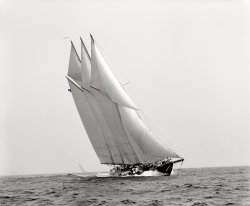
- Little Kittens: 1941
- ... March 1941. "Girls at trailer camp for defense workers. Ocean View, Virginia, outskirts of Norfolk." Medium format acetate negative by ... Posted by Dave - 01/17/2021 - 1:32pm -
![Little Kittens: 1941 March 1941. "Girls at trailer camp for defense workers. Ocean View, Virginia, outskirts of Norfolk." Medium format acetate negative by John Vachon. View full size.
Trying, but failingTo understand the gizmo attached to the bottom of the rear fender on the closest bike. It looks like there is one on the other bike, too.
[It's a kickstand. - Dave]
Well, of course it is. Pretty obvious. Thanks, Dave.
Sweet kidsThat girl in the back is beautiful. She could be a model. I wonder how their lives turned out.
Charming childrenWhat beautiful faces and expressions. The joy of the one with the little book is almost palpable. Some are born to sweet delight.
HappyOnce in a while you see a photo that just makes you happy.
This is one of them !
Wonder womenThese three girls are so charming and elegant, each in her own way. The windswept hair of the young lady in back is terribly alluring, and the kerchief with braids and leather gloves in front is so grown-up. Even little kitten girl is styling with that hand-knotted cloth belt. All three are so pleasing.
Collector's itemIf the young lady who was so proud of her copy of "More About the Four Little Kittens" had taken good care of it, and saved it to this day, she could do quite well selling it online. If my math is right, if she sold it today based on its market price, she could reinvest the proceeds in a Patreon subscription to Shorpy, avoiding ads and getting background versions of pics for three years and four months.
Cool Car Cold WaterThe car looks to be a 1937 Chevrolet Sport Coupe (with a rumble seat!) and the cold water inlet appears to be a hose attached at the clothes line. The young girls are probably sisters. One of them is riding a boys bike but the boy (brother?) is probably okay with it.
I hope no kittens were mistreated."More about the Four Little Kittens" (1938), one of those controversial books by Harry W. Frees that allegedly involved stressful posing of live pets. Delightful for kids, maybe not so much for the kitties.
https://www.barnebys.com/auctions/lot/3_kaqz_69
HeavyThose bikes look like a lot of steel to be pedaling around. I wonder how much they weighed.
Everything to MeFood, shelter, clothing, love and care are essentials but add a bike and books, and life gets pretty close to perfect, and certainly makes other hardships much easier to bear.
Bloody boat anchorsfreddy223, the answer to your question is "between 40 and 50 pounds" (18 to 22 kg). My late mother owned a bike identical to the front one, and it was a trial and a misery to ride due to its weight.
Five window coupeCurvaceous 1935 Ford, showing off it's its well-polished paint.
(The Gallery, Bicycles, Cats, John Vachon, Kids, Norfolk, WW2)](https://www.shorpy.com/files/images/SHORPY-8c18993a.thumbnail.jpg)
- House Beautiful: 1959
- ... Feb. 23, 1959. "Salisbury, residence in Hobe Sound, Fla. Ocean facade. William Kemp Caler, architect. For House Beautiful ." The ... to the tunes... Heaven!
On the beach if it's ocean facade as the intro states, it's likely Jupiter Island. I've seen many ... Posted by Dave - 09/30/2014 - 3:29pm -
![House Beautiful: 1959 Feb. 23, 1959. "Salisbury, residence in Hobe Sound, Fla. Ocean facade. William Kemp Caler, architect. For House Beautiful." The cocktail hour commences on the patio in five minutes. 5x7 inch negative by Gottscho-Schleisner. View full size.
Classic mid-century designThis is one of the best mid-century designs. When I contrast this with the McMansions being constructed today I would choose this in a heart beat. Livable spaces, excellent use of space, reasonable cost of construction and single level explains why this one of the best family home designs of the 20th century. Today building lots are narrow and multiple story designs are popular, but I would choose this is a Mississippi minute! Fortunately there are a lot of these homes on the re-sale market.
And at DuskThe tiki torches come out in force.
Lots of RoomFor a pool and a fire pit.
Invited guests onlyNo alligators or snakes, and no children or small animals to draw them.
Lean on meWhen the big wind comes those tree "braces" will snap like toothpicks
Heir to the WW Kimball Piano CompanyKimball Salisbury was president at one time of the Kimball Piano Company out of Chicago. While I couldn't find much on him online, his wife, Wilmot, was a darling of the Society pages in the newspapers -- google "Mrs Kimball Salisbury" and you'll get a slew of articles.
I haven't pegged where the house was actually located in Hobe Sound, but I doubt I'd be able to because it was listed as an "estate" in one newspaper article, which means it probably wouldn't be visible by Google Street View anyhow.
Mr. Salisbury appears in the 1930 Census living with his wife, two children, and four servants at 1415 Astor Street in Chicago, where he was renting an apartment for $500. That would be somewhere north of $7,000 a month in 2014 money.
I couldn't find them for whatever reason in 1940.
Not a fanThose windows look jalousie.
[Louver come back. - Dave]
Perfect for a house concert!With a few hundred of your best friends on blankets in the grass, the band on the patio, guys on surfboards groovin to the tunes... Heaven!
On the beachif it's ocean facade as the intro states, it's likely Jupiter Island. I've seen many similar style homes there.
(The Gallery, Florida, Gottscho-Schleisner)](https://www.shorpy.com/files/images/SHORPY-5a26486u.thumbnail.jpg)
- Where's My Remote: 1938
- ... storm drains the legend "No dumping/Drain discharges to ocean."
Traffic Jam Imagine the fun of backing out of one of these ... Posted by Dave - 02/20/2013 - 9:34pm -
![Where's My Remote: 1938 July 1938. "Garages in alley behind row houses. Baltimore, Maryland." Which one is ours again? Medium format nitrate negative by John Vachon. View full size.
Thought this was RussiaWhen I first saw this photo I thought it was set in Russia, where I saw many of these garageplexes in every city I visited back in the Soviet days. When you lived in a Stalin-era apartment highrise, you had to have some place to put your car, not so much for parking, but for working on it, because keeping a car running was a challenge back then.
[Not to mention getting one. - Dave]
X marks the spotX marks the spot.
Marble StepsAround front, one set for each garage door.
Malvina Reynoldswrote "Little Boxes"; Seeger (and others) only sang it. She wrote a whole lot of songs, actually; worth looking up on YouTube.
Overhead is BetterHaving endured such a garage (and such garage doors) during a blustery winter in Ft. Leavenworth, I can state unequivocally that getting your car out on a windy morning requires either three people or one driver and two cinder blocks.
The aroma!Those old fashioned wooden garages had SUCH a delicious aroma! A blend of old motor oil, dry, unpainted wood, and who knows what else. Strong, pungent aroma. And you have to look far and wide to find one like this any more.
VERY narrow rowhouses?If the garages are lined up behind the row houses at one garage per, the residences must be very narrow.
Re: Old Garage AromaWe had a garage similar to this when we lived in Brooklyn in the 50's. I know exactly what Jazznocracy means by the aroma. I often accompanied my Dad on the two block walk to the rented garage to retrieve the '39 DeSoto or the '50 Plymouth when we upgraded. Oddly, one of my better memories of that garage was the "lock protector" that Dad crafted from a piece of an old tire to keep the rain out.
Thanks, 'jwp'Hate to come home on a Saturday night and enter this alley from the wrong end. 'The seventh garage on the right side' could turn into a real adventure!
Eau de 10W40That aroma dear to car nuts may have been due to the habit of draining the oil directly onto the garage's dirt floor, where it soaked in (harmlessly, as was thought back then) and perfumed the air for an eon or two. Most of the hazmat that has to be remediated when military facilities are turned over for civilian purposes, for example, can be chalked up to motor fuels/lubricants' and used dry-cleaning fluids' being disposed of by dumping -- a common practice for decades and cetainly not restricted to the military. In fact, coastal cities in California (and presumably elsewhere) often have stencilled on curbs above storm drains the legend "No dumping/Drain discharges to ocean."
Traffic JamImagine the fun of backing out of one of these garages when several of your neighbors, next to and across from you, were doing the same.
Old garage aroma solved.When I built a new garage several years ago, it had the smell of adhesives and curing cement. Ugh. I found an old garage that was about to be demolished not far from my house with a very heavily built 30 foot workbench. At least 50 years old, with paint stains, oil, and who knows what else on it. After liberating it from it's doomed home, my neighbor and I split in half, and now we each have that great smell without the wait.
ListenA variation on a certain Pete Seeger song comes to mind.
Garage vs. house widthThe garages are probably not directly behind individual houses. I don't know where in the city these particular garages are, but here's another Baltimore example.
I heard through a neighborhood oral history project that back when cars were relatively rare, you weren't allowed to leave them on the street! Had to go in a garage at night. There are some in the alley behind our block, but definitely not one per house (we don't have one).
ooo-ooo that smell!As a realtor, I still occasionally get to experience the aroma of old garages here in Tulsa. And it's not just confined to garages. Old homes have their own unique scents as well. Sometimes, too, an old, vacant home can tell you stories if you just observe. For example, I showed one home close to downtown and behind a bedroom door were these different ruler marks notating a child's height as he progressed through life. The years were jotted down - 1930s to 1940s. Old structures will speak to you if you let them.
(The Gallery, Baltimore, Cars, Trucks, Buses, John Vachon)](https://www.shorpy.com/files/images/SHORPY_8b38447a.thumbnail.jpg)
- Baby Ahoy: 1965
- ... Grampa's probably looking at a sailboat out in the ocean. View full size.
Multi ? cooker What do you think the ... the outdoor fire.
Maybe not a sailboat Actually the ocean is straight in front of my Grandfather so It looks like he's looking down ... Posted by twaits - 12/14/2015 - 10:50pm -
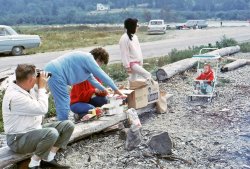
- Patriotic Poriferan: 1920
- ... claws.
Credit to Steven Wright Sponges grow in the ocean. That just kills me. I wonder how much deeper the ocean would be if that didn't happen.
Sponge-diving movies One of my ... Posted by Dave - 01/15/2016 - 8:54pm -
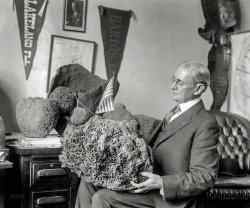
- Prairie Schooner: 1915
- ...
Coastal Confusion Strange that they have the Pacific Ocean (and west coast) east of Staten Island. I hope they didn't just drive ... Posted by Dave - 08/27/2012 - 2:41pm -
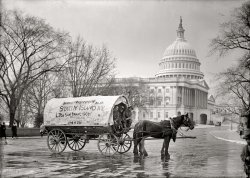
- Gulf Service: 1939
- ... up all that neon, I bet they could guide ships in off the ocean.
Minivan precursor That's a 1938 American Bantam Boulevard ... was located at 518 Alton Road and advertised "Out of the Ocean, into the pan" seafood dining in the "Marine Room".
Can't quite ... Posted by Dave - 04/25/2019 - 6:45pm -
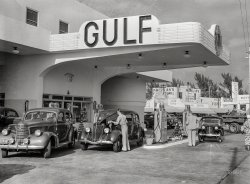
- Bowling Green Offices: 1919
- ... days the usual way to book travel on one of the grand ocean liners like the original Queen Elizabeth or Queen Mary was by going to ... Posted by Dave - 05/31/2013 - 2:05am -
![Bowling Green Offices: 1919 Sept. 20, 1919. "Bowling Green Offices, New York." An interesting view of a construction site next to this early skyscraper, and what might be a new Shorpy record for ghost pedestrians. Photo by Irving Underhill. View full size.
Gambling?Is that group of men in the park to the left of the news-stand playing dice?
[I'm guessing some shoe-shining going on. -tterrace]
Still there!And still quite a grand piece of architecture:
View Larger Map
A demolition siteAt this point, as the city begins to rise from the ground. Are those buildings across the street shuddering with fear?
FascinatingThe street life and vehicles are really interesting. The lighting well in the near side of the Bowling Green Buildings shows what you would get for air circulation in the interior offices in the days before a/c, and even into the 1960's. Note the awnings on the windows in the background.
Cunard BuildingThe building shown in the very early stages of construction in this photo became the Cunard Building, named after the famous steamship line. In those pre-Travelocity days the usual way to book travel on one of the grand ocean liners like the original Queen Elizabeth or Queen Mary was by going to the enormous ticketing hall located in the building's lobby. Other shipping lines and transportation-related companies rented space in the building.
Cunard moved out of the building in the late 1960's, and much of the structure actually was vacant for many years. The grand lobby hall became a post office several years later, and the building now houses a variety of tenants. It is located directly across the street from the famous Charging Bull statue.
Note the painted signs on the side of the Bowling Green Building. They were lost to view when the Cunard Building went up, but chances are very good that they are still there, and still readable thanks to being protected from sunlight. If someday the Cunard Building is demolished while the Bowling Green Building still stands, the signs will (literally) come back to light. It has happened before: http://forgotten-ny.com/1998/05/keals-carriage-manufactory/
On both the right and left sides of the photo you can see an elevated train line. That's the Ninth Avenue El, which ran along Greenwich Street in lower Manhattan, one block west of Broadway. It closed around 1940 and the structure came down soon afterward. On the left of the picture there is a subway entrance in Bowling Green, serving the IRT subway line. There is no longer an entrance at that location.
White Star Linewas located up the steps in the center of the building. Mrs. Benjamin Guggenheim called at the White Star Line to get status of her husband following the sinking of RMS Titanic April 1912.
Still no exorcism?By 1919, one would think, advances in shutter mechanisms and the availability of faster films should have eliminated the ghost pedestrian effect without unacceptable sacrifice of resolution, unless, of course, this was taken with a humongous view camera and plates.
[It was exposed on a glass plate in a view camera, plus a small lens aperture would have been used to maximize sharpness and depth of field; all contribute to the necessity of a longer exposure time. -tterrace]
Sept. 20, 1919On this day Babe Ruth tied Ned Williamson's major league mark of 27 HRs, a record that had stood for 35 years previously. A bit over two months later, the Babe left Boston for New York and became a Yankee.
One BroadwayI had read elsewhere that the current 1 Broadway (the building to the left of the Bowling Green Building) was not built as a new building in the early 1920's, but rather had a limestone facade installed over the extant brick. Discussed in more detail in this post at ScoutingNY.
Castle Brothers steam shovelsCastle Brothers Contractors built Ebbets Field, home of the Brooklyn Dodgers. Today we would call that "local sourcing."
Wrong DirectionThe building to the left is 17 Battery Place, still standing, though the roof has been altered. # 1 Broadway is not in the frame, and it would be to the right of this building.
[17 Battery Place is around the corner and two blocks down. -tterrace]
Aha - the subway entrance threw me. I thought I had Battery Park not Bowling Green Park before me.
Mea Culpa.
What's the name again?Are you sure it's the Bowling Green Offices building? I'm just not positive, there are *only* four signs that say so...
On a side note, the construction site next door reminds me of one of my favorite childhood stores, "Mike Mulligan and his Steam Shovel."
Sixth Ave. lineThe elevated line in the picture is the Sixth Avenue line, on Trinity Place. The Ninth Ave line is on parallel Greenwich St, behind those low buildings along Trinity Pl. Out of sight behind the Bowling Green Building, the two lines come together, and run through Battery Park to South Ferry Station. A bit of the jointly used structure is visible at the left of the picture.
The site for the Cunard Building had been acquired by the City and cleared of older buildings, for construction of the BMT subway angling across from Trinity Place (under the IRT on Broadway) to Whitehall Street. After the subway was completed, the site was sold (with a permanent easement for the subway) and the Cunard Building built.
At the north edge of the site, 39 Broadway was the original terminal of the Metropolitan company's 6th Ave line in 1878. The tracks curved from Trinity Place into this site and ended at Broadway. The original intention of the Metropolitan had been to continue across Broadway into Beaver Street, and then turn north paralleling the Third Ave el. At that time the Metropolitan was a competitor of the NY Elevated RR, which owned the 3rd and 9th Ave lines. When the two companies merged (1880?), this terminal was abandoned and the 6th Ave line made the junction with the 9th Ave to go to South Ferry. The company probably sold the Broadway frontage of the old terminal site, but retained a piece on the Trinity Place side, which was used for a terminal for a package express operation of the el. A siding from the 6th Ave line went into the top floor of this building. This would have been one of the buildings cleared for the subway construction.
Hudson Terminal was several blocks to the right, out of the picture. (Two stops further uptown on the IRT, the BMT and the 6th Ave el).
(The Gallery, Irving Underhill, NYC, Streetcars)](https://www.shorpy.com/files/images/SHORPY_3c23200u.thumbnail.jpg)
- Behind the Boardwalk: 1900
- ... picture, at middle left you will see two piers into the ocean. The first pier comes into the land and ends in a building with two roof ... Posted by Dave - 07/31/2012 - 2:53pm -
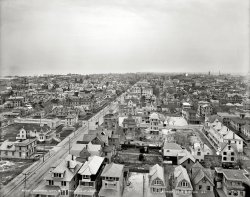
- Alligator Joe: 1904
- ... and described his shtick as wrestling an alligator in the ocean, then climbing on its back and riding it back to shore.
And an ... Posted by Dave - 01/06/2013 - 11:51pm -
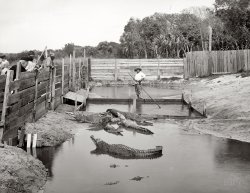
- Don't Go Near the Water: 1918
- ... circa 1918. "Studebaker sedan off Great Highway at Ocean Beach." In the background, below the Sutro Heights observatory and ... Whenever we went near the water on a weekend trip be it ocean, lake or river I would be outfitted in my Keds High Tops, bathing suit ... Posted by Dave - 02/21/2016 - 2:40pm -
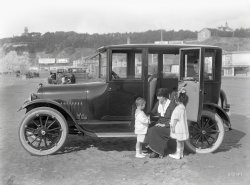
- Cold War Christmas: 1960
- ... Force lieutenant whose plane was shot down over the Arctic Ocean by the Russians, came home in January 1961 after six months in Lyubyanka ... Posted by Dave - 12/07/2008 - 3:27pm -

- Spring Break: 1905
- ... the distance, from the left are Miami Beach (then called Ocean Beach) and the islands of Virginia Key and Key Biscayne.
In later ... Posted by Dave - 07/19/2012 - 12:56pm -
![Spring Break: 1905 Miami circa 1905. "On the shore of Biscayne Bay, Florida." 8x10 inch dry plate glass negative, Detroit Publishing Company. View full size.
The Shadow Knows!Exposed! You can hide behind the camera but you can't hide behind your own shadow. Man with a view camera taking a picture of a man with a view camera taking a picture. Interesting.
Very busy photo!Lots going on here!
There's a Photographer taking a picture, a couple bent over looking at something and it appears those kids in the foreground sent their Chauffeur out to build them a sand castle.
Dinner KeyThis would be Dinner Key in the historic section of Miami known as Cocoanut Grove (later spelled "Coconut"). Other than a small beach downtown, Dinner Key was the only sandy beach along the bay front and a popular picnic spot, hence the name. The natural stone escarpment is the tail end of the Silver Bluff.
In the distance, from the left are Miami Beach (then called Ocean Beach) and the islands of Virginia Key and Key Biscayne.
In later years, this area was filled in and became a seaplane base and home of Pan American Airways. The old PAA Terminal is today's Miami City Hall.
Rock fans will remember Dinner Key as the location of an infamous 1969 Doors concert which led to the arrest of Jim Morrison.
IntegratedI always like seeing that in some areas, some venues, blacks and whites could sit in equal, unseparate enjoyment.
PainterLooking out at those sailboats Winslow Homer would feel like painting.
Where's the sun?Why isn't everybody's shadow falling in the same direction?
[Because the sun is directly behind the camera, the effect heightened by the relatively wide-angle lens, as shown in the example below from this page. - tterrace]
Sand peopleIt appears as they two people have either been buried in sand or someone made sand people.
Also, if this really is Dinner Key, these folks are very close to the set of the USA Network show Burn Notice, in the old Coconut Grove Convention Center. It is also on the far left of the Pan Am seaplane photo in the comments.
(The Gallery, Boats & Bridges, DPC, Florida, Miami, Swimming)](https://www.shorpy.com/files/images/SHORPY_4a12560a.thumbnail.jpg)
- Crank It: 1925
- ... was enabling the first accurate and rapid mapping of the ocean floor. His development of one of the Navy's earliest operational Sonar ... Posted by Dave - 11/10/2012 - 5:05am -
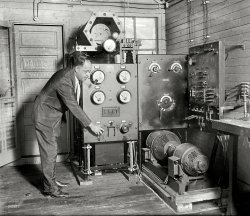
- Galveston: 1905
- ...
To keep deep water out,
But the high tide from the
Ocean spread the water all about.
Wasn't that a Mighty Storm"
-- Huddie ... Posted by Dave - 08/21/2012 - 1:21pm -
![Galveston: 1905 Circa 1905. "Seawall and beach at Galveston, Texas." 6½ x 8½ inch dry plate glass negative, Detroit Publishing Company. View full size.
Galveston Seawall historyThis is probably the first section of the seawall [construction began on this section in 1902 and was completed in 1904], which was built as a result of the Galveston Hurricane of 1900. This initial section was a little over 3 miles long, and would be extended over the years as the Island's population grew westward.
Probably the most interesting thing about the construction of the seawall was the grade raising that was also done as part of the seawall project. The bulidings, homes, and utilities on the east end of the Island [where the majority of population was located at the time] were raised as high as 17 feet, with the space below filled with mud and sand pumped from the floor of Galveston Bay--quite an engineering feat for its time. Check this web site for detailed information and photos concerning the grade raising:
http://www.therealgalveston.com/Grade-Raising.html
For over 100 years, the Seawall did exactly what it was intended to do--protect Galveston from major hurricane damage. Unfortunately, the Seawall met its match in Hurricane Ike in 2008, when the huge storm surge swept over the wall and caused massive flooding, even in the highest part of town directly behind the wall.
But, to show that the Island residents' sense of humor survived Ike, I was down there earlier this year and was in some bar on the Strand (old downtown district). A line was painted on the wall about 7 feet above floor level, indicating the "Hurricane Ike High Water Mark", and just under that, "You must be at least this tall to get drunk in this pub!"
Post-HurricaneIn 1900, a huge hurricane devastated Galveston, killing thousands. Part of the problem was the lack of a seawall. The highest point in the city was only 9 feet above sea level, so when the storm landed with its 15 foot tidal surge, the result was utter destruction. The seawall shown here was built in 1902, and is now 17 feet high. It stood up to the 12 foot storm surge of a 1915 hurricane, though Hurricane Ike in 2008 spilled water over it.
RebarThat has to be a pioneering use of reinforced concrete, yes?
Hurricane of 1900Just finished reading the book "Isaac's Storm" by Erik Larson about the extremely deadly hurricane that hit Galveston in 1900. According to Larson, this seawall was built as a result. About 8,000 people died, and it was costlier than Hurricane Katrina.
Off the mapThe seawall and grade raising were significant engineering feats of their time. However, they couldn't stop the loss of prestige that Galveston suffered after the storm -- Galveston had been the most prosperous and glamorous city in Texas before the 1900 hurricane, but was later surpassed by Houston and Dallas.
Another good book to read is John Edward Weems' "A Weekend in September." Published in 1957, Weems interviewed numerous survivors who offered gripping, and sometimes inspiring, eyewitness accounts of the horrors of that weekend. An interesting note is that one could still see high water marks from the flood on some of the since-raised houses, even in the 1950s.
Galveston Had a Seawall"Galveston had a seawall
To keep deep water out,
But the high tide from the
Ocean spread the water all about.
Wasn't that a Mighty Storm"
-- Huddie Ledbetter
Point of orderThe board of engineers that designed the Galveston seawall was chaired by retired Brigadier General Henry Martyn Robert (not Roberts), best remembered to posterity as the author of the Pocket Manual of Rules of Order for Deliberative Assemblies, more readily known as Robert's Rules of Order.
Hurricane IkeA lot of Ike's damage in Galveston was the storm surge that came from the bay side of town, which is not protected like the beach side. The historic commercial district The Strand took 8 feet or more of water. I was down there for Mardi Gras 2009, and someone had painted an Ike "high water mark" on a building in The Strand.
The WallIt is my understanding (from being a local - living in an evac zone on the mainland just north of Galveston) that the seawall did its job during Ike, but that the flooding was from the storm surge moving around the seawall, especially through the harbor entrance and to a lesser extent, the non-protected west side. The surge inundated the island from behind. The good aspect of this is that it was flooded rather than scoured with a powerful tidal force, like Bolivar on the other side of the harbor with no sea wall. The storm surge fiercely destroyed, scoured and eroded the peninsula, while Galveston proper (behind the seawall) was more 'gently' flooded.
The seawall is still only going to serve mostly to break the forward advance, but the fact is the island slopes down and away from it toward the bay, and any significant storm surge will flood. The surge won't slam and scour, though.
Hurricane Ike was not too bad of a wind storm, its damage was the massive, unusually large surge. Wind-wise, Galveston has endured worse, we even kept our roof, but surge-wise it was massive! Without the seawall it would have been cataclysmic. Good engineering 100 years old still doing its job!
Looking eastThis may have been taken around 15th or 16th Street looking east, as you can see where the wall makes a jog to the left, out of sight, in the distance. That's between 12th and 13th Streets.
Other serious hurricanes came through in 1909 and 1915, and it was discovered that the small rocks shown here at the foot of the wall were insufficient to protect it, and larger, pink granite "rip-rap" were put down instead.
In the distance one cane see a steam crane, possibly at work laying the rocks at the foot of the wall farther east.
(The Gallery, DPC, Swimming)](https://www.shorpy.com/files/images/4a24976a.thumbnail.jpg)
- Mother: 1933
- ... the word sand, you may think of a child's sand box or an ocean beach. Yet we depend on industrial sand for many uses. ...
(The ... Posted by Dave - 08/23/2012 - 11:36am -
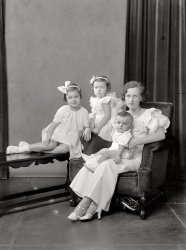
- The Heart of New York: 1907
- ... and Manhattan for delivery in the city or loading on to ocean going vessels. Thus explaining why all the great photographs I've seen on ... Posted by Dave - 08/21/2012 - 12:38pm -
![The Heart of New York: 1907 Circa 1907. "The heart of New York (Manhattan skyline from Brooklyn)." The Singer Building rises. 8x10 glass negative, Detroit Publishing Co. View full size.
Ghost TownNot a soul in sight!
[They are there, just really tiny. - Dave]
Even TodayThe best views of Manhattan are from Brooklyn, Queens and New Jersey.
Singer TowerThe Singer (sewing machine company) tower, under construction was the tallest building in the world for a couple of years. It was demolished at a youthful 60-years old.
Tall ShipsIt is interesting to see ships with masts and sails plying the waters around Manhattan. There is a large three masted ship tied up to the pier, slightly left of center. I can remember going to The South Street Seaport Museum to look at the Peking and the Wavertree.
Indecently, the South Street Seaport Museum is located at Pier 16 On the East River. Pier 16 is the right hand pier of the two Mallory Line Piers.
Transportation History DivinedI just realized how the waterfront railroad terminals in New Jersey worked!
If you look closely, several of the barges are from the Lehigh Valley Railroad, which ran from that region of Pennsylvania to Jersey City. I must presume that the goods that were to be transshipped from freight cars to ships or the city itself were loaded on to barges and then delivered to the deep water piers in Brooklyn and Manhattan for delivery in the city or loading on to ocean going vessels. Thus explaining why all the great photographs I've seen on Shorpy feature so many small barges, lighters, and other riverine craft.
I imagine the completion of the New York Central Railroad's High Line was a serious blow to the LVRR and other lines on the New Jersey side of the Hudson and the Holland Tunnel doubly so. Imagine what New York City would be like if there had been a more efficient rail system from New Jersey to the docklands of the East River.
How did it take me so long to figure this out?!
What's going on here?Heavy traffic out there! Up until the 1960s-1970s, various railroads transferred huge amounts of cargo to and from the city by barges called carfloats carrying rail cars. Several railroads had small switching yards isolated from their main lines fed by carfloats, plus warehouses as well. Those railroads also often had their own “navies” of tugs and barges to transfer cargo to and from ships in the harbor..
Note the covered barges (AKA house barges) in the foreground marked for the Lehigh Valley RR. The one at far right is owned by the Lackawanna RR. The covering structure allowed secure storage and protected cargo from the weather during transfer. Covered barges had side doors to allow direct transfer to freighters that also had side doors. The freighter in foreground right looks to be transferring cargo via one of the barge’s roof hatches located over its side door.
At far left are 2 hold barges, apparently one with coal being loaded onto the ship alongside. Those barges were mostly owned by coal companies.
A stick lighter (AKA gas hoister) is at bottom right with others elsewhere in the picture. Essentially a derrick on a barge, they were used to handle heavy/bulky items. The bigger one opposite is a self-propelled steam lighter. Those were used for making faster transfers of goods – no waiting for tug service.
A good reference is “New York Harbor Railroads in Color, Volume 1” by Thomas R. Flagg (Morning Sun Books, 2000)
(The Gallery, Boats & Bridges, DPC, NYC)](https://www.shorpy.com/files/images/4a22396a.thumbnail.jpg)
- Bar Harbor Panorama: 1901
- ... much earlier sunrise was, but remember the sounds of the ocean coming in the barracks windows at night from Schoodic Point.
Tipping ... Posted by Dave - 10/14/2021 - 11:05am -
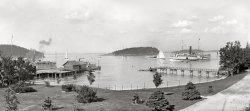
- Sport Mart: 1923
- ... bathing suits; must be for those January 1st dips in the ocean.
Toymaker I suspect the "Toymaker" box near the door is a kit for ... Posted by Dave - 02/18/2013 - 5:40pm -
![Sport Mart: 1923 Washington, D.C., 1923. "Sport Mart, 1410 New York Avenue N.W." Continuing our day of window-shopping. National Photo glass negative. View full size.
Twinplex StropperFound one of these in the attic of my grandparents' Lake Huron house in Michigan many years ago.
Please Dave!!??Can we stop for a malted milk after window shopping? I promise we'll all be good.
Converse All StarsThis is probably one of the last photos of a pair of Pre-Chuck Taylor Converse All Stars. In 1923 the patch was redesigned with Chuck Taylor's signature.
Pure wool bathing suitsThey certainly must have itched!
MizpahFront right, we have the No. 44 Mizpah Jock Supporter, which comes with a two week trial - just return it if you find it unsatisfactory. (Fortunately, it can be boiled, which was probably a wise thing to do before putting it on for the first time, given the return policy.)
A more intimate version of Mizpah jewelry, perhaps? "The Lord watch between me and thee, when we are absent one from another," indeed!
$3.95 for a wool bathing suitSuspect the itching and scratching were free of charge.
Sports Technology!Based on the description found on Google Books, I was excited to see the Brooks Golf Stroke Counter. I thought it counted stokes by detecting the movement of the arms in a swing, kind of like a pedometer detects steps, which would make it a seminal device. Alas, I learned from patent application 1,460,842 granted on July 23, 1923 that the golfer had to click it to count his strokes, thereby making it subject to cheating despite the claims to the contrary. What easier way to cheat in golf than "forgetting" to click your high-tech counter?
"A huge maintenance hassle"To quote Dave on awnings, three posts back (One-Chevy Home:1964). For evidence, please note the narrow panel of the awning, running the width of the shop, just above the fringe with the name and address, where one can view holes that have been patched and holes that have not been patched.
KedsGee, I had no idea Keds went back that far.
That was what we had before there were Nikes, Reeboks, etc.
And wool bathing suits sound so uncomfortable.
For members of the Polar Bear ClubPure wool bathing suits; must be for those January 1st dips in the ocean.
ToymakerI suspect the "Toymaker" box near the door is a kit for casting figures in lead. Can you imagine the outcry if you were to attempt to sell such a toy today? People would be apoplectic! Give me back my THING MAKER! Sure, I have a scar or two from the hotplate, but it was worth it.
[Used with wood. - tterrace]
My old neighbor ChuckLove the Converse All Stars. Shoes invented by Chuck Taylor, who spent some time in my hometown of Azalia, IN.
Sport Mart MerchandiseSport Mart had locations at 914 F St. N.W., 1303 F St. N.W.,
and 1410 N.Y. Ave. N.W. The following lists some of the suppliers for the sporting goods they carried (compiled from Jun 5, 1923 Washington Post).
D. Nusbaum Co., Union Course, L.I., Bathing Suits.
John Spicer, Inc., Brooklyn, N.Y., Bathing Suits.
Gantner & Mattern, San Francisco, Calif., Bathing Suits.
Armstrong Knitting Mills, Boston, Mass. Distinctive Knit Jackets.
Revere Knitting Mills, Malden, Mass, Sweaters.
Kenneth Harbison, Inc., 720 Herkimer St., Brooklyn, N.Y., Athletic Clothing.
E. Weisbrod Sons, Greenfield, Mass., Leather Bill Folds.
Newtown Line Co., Homer N.Y., Fish Lines.
Pflueger's Fishing Tackle, Enterprise Mfg. Co., Akron, Ohio.
H.S. Frost Co., New York, N.Y., Snelled Fish Hooks.](https://www.shorpy.com/files/images/SHORPY_24465u.thumbnail.jpg)
- Mixed Message: 1917
- ... appearing to be surrounded at the waterline by a tiny ocean made out of whatever they used to fill Easter baskets before plastic ... Posted by Dave - 06/20/2012 - 4:05pm -
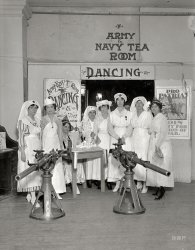
- Bachelor Miner: 1937
- ... Maybe he's a Welshman and the picture reminds him of the ocean. Maybe he just wants a scene with sunlight. I have a miner friend here in ... Posted by Dave - 03/11/2013 - 12:12pm -
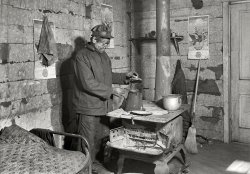
- Shore Fastline: 1908
- ... connects Atlantic City, Pleasantville, Somers Point and Ocean City and by traffic agreement with the West Jersey & Sea Shore R. R., ... Posted by Dave - 07/22/2015 - 10:15am -
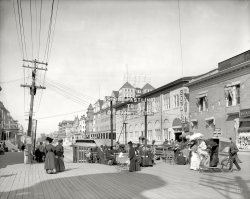
- Long Beach Parade: 1953
- East Ocean Blvd. and North Locust Avenue, Long Beach, California.
Stamped on the ...
All gone In the 1990s I lived at Linden Ave and Ocean Blvd, a few blocks to the east of this location. Needless to say, ... of us is wearing an American Legion cap
In the 1970s Ocean Blvd took a downward turn and crashed economically and socially, though ... Posted by Hoople365 - 03/16/2012 - 10:04pm -
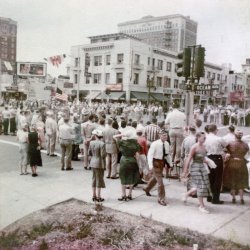
- The Deep End: 1925
- ... of pastel yellow and coral, the pool tiles are a lovely ocean blue, and the ceiling... well, we just won't look up.
Hey, the water ... Posted by Dave - 01/08/2013 - 6:43pm -
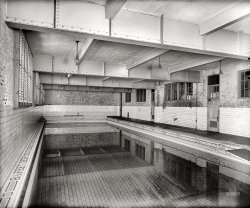
- Asbury Park: 1905
- ... olde beach photos, folks seem to just come and look at the ocean. Like, "Well, there it is, can we go home now?"
Circa 1963 or ... Posted by Dave - 01/19/2012 - 8:53am -
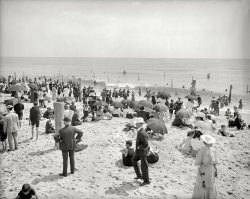
- Par Avion: 1918
- ... to fly from Washington to Philadelphia. “The Atlantic Ocean and lack of gas prevent him going further,” Fleet said.
Fleet’s ... Posted by Dave - 08/28/2012 - 1:41pm -
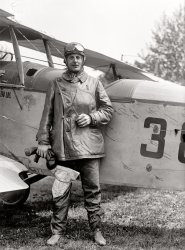
- A Ride on the Boardwalk: 1907
- ... convenient of the hotels in Atlantic City. Being at the ocean end of North Carolina avenue, it commands an unobstructed view of the ocean and the boardwalk, and during the twenty years that Mr. Leeds has been ... Posted by Dave - 08/09/2012 - 2:41pm -
![A Ride on the Boardwalk: 1907 The Jersey Shore circa 1907. "Haddon Hall and Boardwalk, Atlantic City." 8x10 inch dry plate glass negative, Detroit Publishing Company. View full size.
Steamboat Gothic.It may not be on the Mississippi, but Haddon Hall certainly presents all the features of the style.
AmpleLady on the right would be described by my grandmother as a Lady of Ample Bosom. Beautiful photo, thanks.
Capturing life's momentsA great photo to study people of yesteryear. For instance, the handsome couple on the extreme right, strolling along in what appears to be an intense conversation. How cool would it be to recognize, from old family photos, your grandfather and grandmother or even great-grandma and grandpa in their youth? Also interesting in these type photos are the clothes of kids such as the little boy at the end of the ramp with shorts and one of those wide brimmed hats and the teenage girl with ribbons - just as we have seen in old movies. Shorpy is more than a business - it is a great service to understanding past times.
Leeds & Lippincott
Genealogical and Memorial History
of the State of New Jersey, 1910.
In 1890 he [Henry West Leeds] came to Atlantic City and opened Haddon Hall, in partnership with J. Haines Lippincott. Subsequently his mother sold out her interests in the Tremont House and joined with her son in operating Haddon Hall, and winning for it its wide and popular reputation as a homelike hotel. The hotel will accommodate four hundred and fifty guests, and is one of the most central and convenient of the hotels in Atlantic City. Being at the ocean end of North Carolina avenue, it commands an unobstructed view of the ocean and the boardwalk, and during the twenty years that Mr. Leeds has been connected with the house, he has established a most enviable reputation among people of culture and refinement. The house is beautifully furnished and decorated, and on its walls can be seen the best collection of water colors of any seaside resort hotel in the country. The hotel is open all the year.
Stayin' FitI have a strong suspicion that pushing one of those carts about over the course of a season kept one in pretty good shape. I wonder how far these folks usually covered in a day.
(The Gallery, Atlantic City, DPC)](https://www.shorpy.com/files/images/SHORPY_4a18716a.thumbnail.jpg)
- American Dream: 1960
- ... living five years in the inland south (no road salt, no ocean air).
In 1965 I bought a 1955 Ford (Florida car, no radio - no ... Posted by Dave - 08/30/2015 - 8:21pm -
![American Dream: 1960 "Two-car families." Columbus, Georgia, circa 1960. Three Fords, an Oldsmobile and a Pontiac. 4x5 acetate negative from the News Archive. View full size.
Day LaborThe two Fords in the foreground don't seem to fit the neighborhood. I suspect they belong to the masons laying the new brick garage behind the two story on the right.
But Ward!My Bridge Club is due to arrive at any moment and Wally parked his Jalopy right in front of the house!
Country SquireThe wagon may be a 1960 Ford Country Squire, need to see a bit more to be certain.
[There's enough showing that we'd be able to see a sliver of the faux-wood side panel if it were, so this is a Ranch Wagon or Country Sedan. -tterrace]
Rust BucketThe 1955 Ford seems to have a lot of rust for living five years in the inland south (no road salt, no ocean air).
In 1965 I bought a 1955 Ford (Florida car, no radio - no heater) off of the Pentagon bulletin board and it had no rust. (purchased for $25.00.. sold 18 months [and one very cold winter] later for $25.00)
Wonder if the '55 could be a transplant from the rust belt??
Chrome memoriesI learned to drive using a 1958 Pontiac Star Chief 4-door (4-speed automatic, 370 cubic inch 4-barrel) that was loads of fun to drive. And the chrome! My, oh my, the chrome!
That '55 FordHas seen some hard times in its five years on the earth--looks more like it should in 1965.
The Ford center framejudging by the rust, is visiting from Detroit or Buffalo
Hey, what's the deal?None of these cars have smashed into each other.
[It's not in Oakland. -tterrace]
Chicago area.This architecture is characteristic of Chicago, where I grew up. The brick and the stone, the awnings, even the garage door design, makes me believe this photograph was taken, perhaps, in the Sauganash neighborhood. I have a hard time believing it is Georgia. Maybe that explains other comments about the rusted cars.
(The Gallery, Cars, Trucks, Buses, Columbus, Ga., News Photo Archive)](https://www.shorpy.com/files/images/SHORPY-615.thumbnail.jpg)























